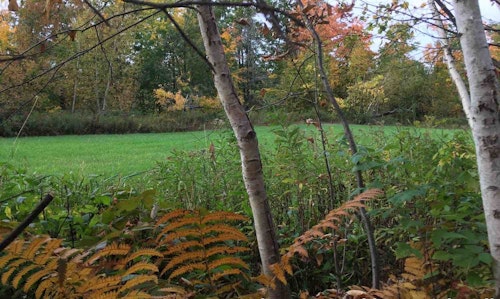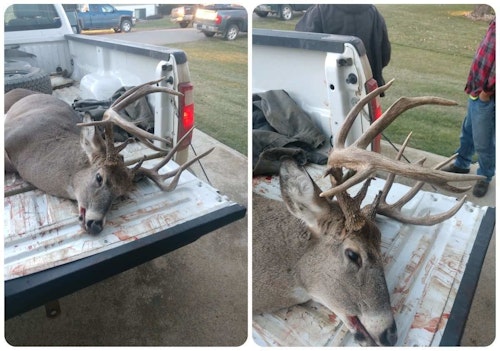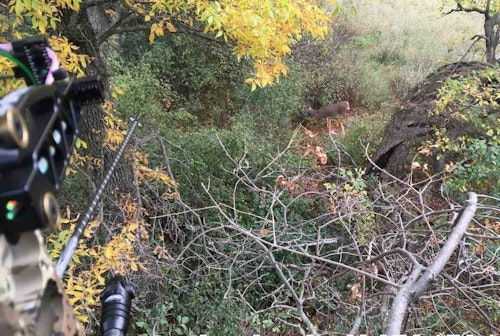what angle do you have to shoot yourself to die

Shot altitude on the author's 2021 S Dakota buck was only 8 yards. Look closely and you see the hang-on stand in the background of the arrow photo. The 5x5 ran only 25 yards and was dead in less than a minute.
Like many of you, I bask watching whitetail bowhunting content on YouTube. Even though I've been pursuing whitetails with stick and string for 45 years, I frequently learn something new, either from the testify's host, or from deer beliefs captured on video.
Sadly, many YouTube hunters frequently demonstrate a "shoot at whatsoever costs" attitude when a whitetail — a shooter! — walks within bow range. And while I'k not influenced past their poor choices, I cringe when watching it because I know that many viewers look up to these hosts equally experts. These new hunters volition probable brand the aforementioned poor decisions in the field because they don't know whatsoever improve.
Specifically I'g referencing bowhunters who attempt anything other than slam dunks or chip shots (cull whichever sports analogy works for you). When a host says anything similar to the statements below, I shake my head and wish he or she would've passed on the opportunity:
- The buck slipped in behind me, so I took the best shot he gave me.
- The buck didn't stop in my shooting lane, and I had to sneak 1 through a tiny opening.
- The buck was broadside but looking correct at me. I recollect he jumped the string. I striking him high.
- I had to thread 1 through the brush. He was so close!
- The buck was going to run if I waited whatsoever longer. I had to shoot him even though he was facing me.
- The buck circled across my decoy, so it was farther than I'd planned. I didn't accept time to range him. I think he was nigh 35 yards.
- I bleated at him, simply he wouldn't terminate. I had to shoot him walking. I hit him low and too far back.
Yous go the idea. In all cases, the hunter offers a reason or excuse as to why this or that happened, as well equally why they "had to shoot."
Really, they HAD to shoot? Why?
I don't know the standard-of-living situations of these bowhunters with YouTube channels, just I'm confident they aren't starving, and neither are their dependents. I doubt a single one of them MUST kill a deer at that moment or they'll go hungry in the days, weeks and months ahead. I offering this insight based on the fact almost of them are using the latest-and-greatest gear. Add up the retail price of all their hunting equipment in the tree (including apparel) and information technology's likely north of $2,000. Tack on photographic camera gear and it's probably more than than $three,000.
If you lot're new to bowhunting, my No. 1 chip of advice is shoot only when the situation is perfect. Actually, that's my advice to any bowhunter, regardless of experience. I'll explain what I mean past "perfect" in a moment.
Of grade, the downside to adhering to my recommendation is you lot might take to eat tag soup at the end of archery season. To that I say, "So what?" Don't get sucked into the trap of thinking you must post pics of a mature buck year later twelvemonth on Instagram or Facebook or your "friends" volition retrieve less of you lot as a hunter. Why you lot chase and what yous shoot is your determination. Don't let the social media mob influence you.
Whitetails aren't targets; they aren't made of newspaper or self-healing foam. Attempting to kill an animal is serious business and shouldn't be taken lightly.

In the nutrient plot scenario above, the author has cleared i shooting lane; you tin can clearly see information technology in the left one-third of the photo. If a deer is feeding anywhere else in the field, there'south no shot considering the chance of hitting an obstruction (weed pinnacle, etc.) is as well high. And size of deer is irrelevant. No shooting lane = no shot.
So, what do I define as a perfect shooting opportunity? Here'southward my checklist earlier releasing an arrow:
Deer is unaware of my presence.
Don't fool yourself; a deer can jump the string (crouch low to begin running) from any distance. If 2 deer jump the cord the moment your bow fires, the one that'due south farthest away will movement the almost, but a deer can move significantly at even point-blank bow range. If a deer has busted me and appears set to abscond, and so I don't shoot. And buck size is irrelevant.
During early November 2021 in S Dakota, I passed a 30-1000 broadside shot on the biggest buck I've seen in many years — a heavy 5x5 with a five-inch driblet tine that scored 161 when killed by a gun hunter a week subsequently (photo below). Why? Because he was staring at me as I hid in a natural ground bullheaded. I didn't even endeavor to draw my compound. I figured the chance of him jumping the cord was at to the lowest degree 90 pct. I didn't want to gamble wounding him. He won that circular, and I let him walk away.
FYI: Six hours later, I had the aforementioned buck at only 17 yards from the aforementioned ground blind. He was following a hot doe. Again, he stared right at me, this fourth dimension from a quartering-toward bending. I didn't attempt to shoot. He knew I was there, so he won. Again. And I'yard okay with that outcome.

The author passed on this Due south Dakota drop-tine bruiser because he thought the risk of the buck jumping the string was high. It was killed a week subsequently by a gun hunter.
Shooting lane is clear.
Depending on terrain, yous can sometimes get away with taking a shot at a deer that slips in from an unexpected direction. Virtually of the time, however, attempting a shot at a deer that isn't standing or walking slowly through a planned shooting lane is a recipe for disaster. Don't try to slip an arrow through a tiny hole in branches. Don't call back that alpine grass won't affect arrow flight. No matter how close a deer is, and no thing how hard you've hunted upwards to this indicate in the season, and no matter how many days of hunting you take left, you shouldn't force a shot through embrace. The shooting lane must be clear — non mostly articulate, it must be totally articulate.
If your pointer deflects and you make a marginal hit on a deer, and then instead of a deer living less than 1 infinitesimal after a perfect double lung shot, it'll alive 8, 12 or 24 hours. Maybe even more. Sure, you lot might eventually find the hit deer and the meat might nevertheless be expert, assuming it's common cold enough, just why risk it? We owe it to our quarry to brand quick killing shots.
One more note regarding clear shooting lanes: Many YouTube hunting shows today focus on public land and a technique called "hang and hunt," which often requires the use of a saddle. It means you hike in, find a spot that mayhap yous've scouted only via a hunting app, climb a tree and and then wait on a whitetail. This can exist a deadly system, merely 1 major downside is the lack of clear shooting lanes. It's illegal to trim shooting lanes on many public lands, and fifty-fifty if it were legal, these highly mobile bowhunters aren't conveying a pole trimmer. Unfortunately, these hunters are oft faced with poor shooting lanes at all-time, and the result is a much college percentage of deflected arrows. Not proficient. These hunters must be supremely disciplined to avert making marginal shots on whitetails.
Deer is stopped or walking slowly at very close range.
I've killed plenty of deer afterwards making them end with a bleat, and plenty more than as they walked slowly passed me at 5 to 15 yards. Every state of affairs is unlike, and I make the carve up-second decision on whether to make a bleat to end a deer based on the deer'southward behavior. What I will never do — and have never washed — is try a shot on a walking deer at distances of twenty yards or more. Why? The chance of hit the deer as well far back goes up dramatically as you increase distance.
Information technology's irrelevant that yous tin can put 10 arrows in a row into a poker chip at 20 yards, or hit a softball-sized bull'southward-heart every time at 60 yards — or 100. You tin can't exercise shooting a walking creature at xxx or 40 yards. And even if you somehow rigged a 3-D deer target on wheels with pulleys and such to mimic a walking whitetail, at that place'south no guarantee the existent deer will go along its steady and tiresome pace; it might stop at the very moment you release the arrow, or speed up slightly. It'due south not worth the take chances. If a big buck is walking passed me at 25 yards and doesn't stop when I bleat, then I don't shoot. He wins.
Acceptable shot angle.
Annotation that I didn't say a deer had to be broadside or slightly quartering away, although these are certainly the best shot angles. I've killed deer with head-on and quartering-toward shots, but only from the basis at very shut range (12 yards and less). The reason is when arrow penetration combines one lung with liver, which is the result when I'grand on the ground, a deer will die very apace.
Attempting quartering-toward shots from a treestand oftentimes result in single-lung-only hits, which aren't always fatal. A bowhunter shooting heavy poundage, a heavy arrow, and using a super-sharp cut-on-contact broadhead tin send an arrow through a deer's shoulder or front end leg os, merely it won't affair if you don't hit both lungs, or hit the middle. In my stance, the margin for error is likewise pocket-size to try this shot. Look for a better angle, and if it doesn't happen, then permit the deer walk. You don't accept to shoot.

In the woodland scenario beneath, the author has cleared two shooting lanes. The doe has entered the right lane and is walking toward the left lane. Note: The photograph was taken while the author was sitting; when he stands, the shooting lane is perfectly articulate.
The S Dakota buck I killed in 2021 (top photo) wasn't the biggest cadet I had within 25 yards this archery season. In fact, he doesn't even make the top five. But those bigger bucks never gave me a perfect shot opportunity, and then I kept hunting — kept grinding — and waited for a better opportunity. Finally my patience was rewarded with a broadside shot at a continuing 5x5 at only 8 yards, and he didn't have a clue I was in the county.
For me, bowhunting is about seeing how close I can seal the bargain, non how far. Nothing is guaranteed in bowhunting, but I like my odds of making a quick, make clean kill on a stationary or slowly walking, relaxed whitetail at very shut range through a wide-open shooting lane. Settle for nothing less and your percent of double lung hits will skyrocket.
Source: https://www.grandviewoutdoors.com/whitetail-deer/whitetail-bowhunters-you-dont-have-to-shoot
Post a Comment for "what angle do you have to shoot yourself to die"